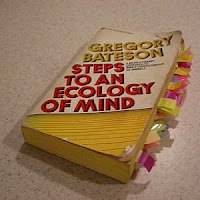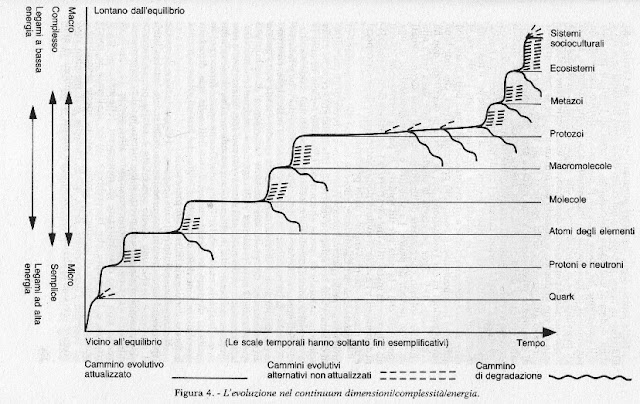Metalogue: Why a Swan?
Daughter: Why a swan?
Father: Yes—and why a puppet in Petroushka?
D: No—that's different. After all a puppet is sort of human—and that particular puppet is very human.
F: More human than the people?
F: More human than the people?
D: Yes.
F: But still only sort of human? And after all the swan is also sort of human.
D: Yes.
* * *
D: But what about the dancer? Is she human? Of course she really is, but, on the stage, she seems inhuman or impersonal—perhaps superhuman. I don't know.
F: You mean—that while the swan is only a sort of swan and has no webbing between her toes, the dancer seems only sort of human.
D: I don't know—perhaps it's something like that.
* * *
F: No—I get confused when I speak of the "swan" and the dancer as two different things. I would rather say that the thing I see on the stage—the swan figure—is both "sort of" human and "sort of" swan.
D: But then you would be using the word "sort of" in two senses.
F: Yes, that's so. But anyhow, when I say that the swan figure is "sort of" human, I don't mean that it (or she) is a member of that species or sort which we call human.
D: No, of course not.
D: No, of course not.
F: Rather that she (or it) is a member of another subdivision of a larger group which would include Petroushka puppets and ballet swans and people.
D: No, it's not like genera and species. Does your larger group include geese?
F: All right. Then I evidently do not know what the word "sort of" means. But I do know that the whole of fantasy, poetry, ballet, and art in general owes its meaning and importance to the relationship which I refer to when I say that the swan figure is a "sort of" swan—or a "pretend" swan.
D: Then we shall never know why the dancer is a swan or a puppet or whatever, and shall never be able to say what art or poetry is until someone says what is really meant by "sort of."
F: Yes.
D: But we don't have to avoid puns. In French the phrase espece de (literally "sort of") carries a special sort of punch. If one man calls another "a camel" the insult may be a friendly one. But if he calls him an espece de chameau—a sort of camel—that's bad. It's still worse to call a man an espece d'espece—a sort of a sort.
D: A sort of a sort of what?
D: A sort of a sort of what?
F: No—just a sort of a sort. On the other hand, if you say of a man that he is a true camel, the insult carries a flavor of grudging admiration.
D: But when a Frenchman calls a man a sort of camel, is he using the phrase sort of in anything like the same way as I, when I say the swan is sort of human?
* * *
F: It's like—there's a passage in Macbeth. Macbeth is talking to the murderers whom he is sending out to kill Banquo. They claim to be men, and he tells them they are sort of men.
Ay—in the catalogue ye go for men.as hounds and greyhounds, mongrels, spaniels, curs,shoughs, water-rugs and demi-wolves are cleptall by the name of dogs.(Macbeth, Act III, Scene 1)
D: No—that's what you said just now. What was it? "Another subdivision of a larger group?" I don't think that's it at all.
F: No, it's not only that. Macbeth, after all, uses dogs in his simile. And "dogs" means either noble hounds or scavengers. It would not be the same if he had used the domestic varieties of cats—or the subspecies of wild roses.
D: All right, all right. But what is the answer to my question? When a Frenchman calls a man a "sort of" camel, and I say that the swan is "sort of" human, do we both mean the same thing by "sort of"?
* * *
F: All right, let's try to analyze what "sort of" means. Let's take a single sentence and examine it. If I say "the puppet Petroushka is sort of human," I state a relation-ship.
D: Between what and what?
F: Between ideas, I think.
D: Not between a puppet and people?
F: No. Between some ideas that I have about a puppet and some ideas that I have about people.
D: Oh.
* * *
D: Well then, what sort of a relationship?
F: I don't know. A metaphoric relationship?
* * *
F: And then there is that other relationship which is emphatically not "sort of." Many men have gone to the stake for the proposition that the bread and wine are not "sort of" the body and blood.
D: But is that the same thing? I mean—is the swan ballet a sacrament?
F: Yes—I think so—at least for some people. In Protestant language we might say that the swanlike costume and movements of the dancer are "outward and visible signs of some inward and spiritual grace" of woman. But in Catholic language that would make the ballet into a mere metaphor and not a sacrament.
D: But you said that for some people it is a sacrament. You mean for Protestants?
F: No, no. I mean that if for some people the bread and wine are only a metaphor, while for others—Catholics —the bread and wine are a sacrament; then, if there be some for whom the ballet is a metaphor, there may be others for whom it is emphatically more than a metaphor—but rather a sacrament.
D: In the Catholic sense?
F: Yes.
* * *
F: I mean that if we could say clearly what is meant by the proposition "the bread and wine is not `sort of' the body and blood"; then we should know more about what we mean when we say either that the swan is "sort of" human or that the ballet is a sacrament.
D: Well—how do you tell the difference?
F: Which difference?
D: Between a sacrament and a metaphor.
* * *
F: Wait a minute. We are, after all, talking about the per-former or the artist or the poet, or a given member of the audience. You ask me how I tell the difference between a sacrament and a metaphor. But my answer must deal with the person and not the message. You ask me how I would decide whether a certain dance on a certain day is or is not sacramental for the particular dancer.
D: All right—but get on with it.
F: Well—I think it's a sort of a secret.
D: You mean you won't tell me?
F: No—it's not that sort of secret. It's not something that one must not tell. It's something that one cannot tell.
D: What do you mean? Why not?
F: Let us suppose I asked the dancer, "Miss X, tell me, that dance which you perform—is it for you a sacrament or a mere metaphor?" And let us imagine that I can make this question intelligible. She will perhaps put me off by saying, "You saw it—it is for you to decide, if you want to, whether or not it is sacramental for you." Or she might say, "Sometimes it is and sometimes it isn't." Or "How was I, last night?" But in any case she can have no direct control over the matter.
* * *
D: Do you mean that anybody who knew this secret would have it in their power to be a great dancer or a great poet?
F: No, no, no. It isn't like that at all. I mean first that great art and religion and all the rest of it is about this secret; but knowing the secret in an ordinary conscious way would not give the knower control.
* * *
D: Daddy, what has happened? We were trying to find out what "sort of" means when we say that the swan is "sort of" human. I said that there must be two senses of "sort of." One in the phrase "the swan figure is a `sort of' swan, and another in the phrase "the swan figure is `sort of' human." And now you are talking about mysterious secrets and control.
F: All right. I'll start again. The swan figure is not a real swan but a pretend swan. It is also a pretend-not human being. It is also "really" a young lady wearing a white dress. And a real swan would resemble a young lady in certain ways.
D: But which of these is sacramental?
F: Oh Lord, here we go again. I can only say this: that it is not one of these statements but their combination which constitutes a sacrament. The "pretend" and the "pretend-not" and the "really" somehow get fused together into a single meaning.
D: But we ought to keep them separate.
F: Yes. That is what the logicians and the scientists try to do. But they do not create ballets that way—nor sacraments.
































































